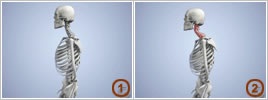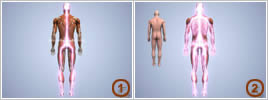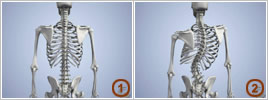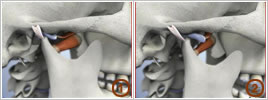 |
|
|
 |
||
 |
||
|
SYMPTOM PROFILES Through extensive research and study chiropractors have identified 5 components of the vertebral subluxation. Collectively, these elements are known as the "subluxation complex".
Each component of the subluxation must be eliminated for proper healing to occur and for the rehabilitation process to be successful. While full understanding of all components is not necessary, you should be aware of the complexity involved. Patients should also be aware that pain is but a small element of most diseases and disorders. Pain is a very poor indicator of your need for further treatment as pain generally subsides well before tissue healing and mechanical normalization has completed.
Arthritic or degenerative change is our body’s natural response to abnormal loads (mechanical stress) placed upon a particular region of the affected joint. Let me explain this by illustrating a process called Wolff’s Law. Wolff’s Law states that when increased loading on a bone occurs, the bone will remodel itself by laying down more bone mass and will become stronger over time to adapt to the increased load forces. This occurs as a natural metabolic process in our body and in fact, our skeleton is replaced every few years as a result of this process. With degenerative change, the same phenomena is true-however, the joint affected by arthritis allows abnormal forces to be placed upon the bone. The bone is then remodeled in an abnormal pattern in an attempt to provide support or buttress the joint. This is why arthritic joints can become painful, stiff, achy and have decreased ranges of motion. Chiropractors see many patients with degenerative arthritis. The spine is especially susceptible to this disorder. In fact, you may have the early signs of spinal degenerative arthritis but just have not noticed the symptoms yet. Simple palpation (feeling) of the vertebrae while the spine is slowly being moved can discover joints that do not move as freely as other joints do. This is one finding that could lead to a diagnosis of degenerative arthritis.
Your head should sit directly on your neck and shoulders just like a golf ball would sit on a tee. The weight of the head is more like a bowling ball than a golf ball, so when it starts to move forward out of alignment it as you would hold a bowling ball in the air at an angle it would put a great strain on your forearm as well your head will put a strain on the muscles of the neck and upper back. The result can be muscle fatigue and subluxation. Left untreated over long periods of time it can become chronic and debilitating. Early intervention the chiropractic adjustments and other modalities will restore the head back to its normal position and ease the strain on the supporting tissues.
Each spinal disc has a jelly-like "ball bearing" core that is contained by bands of fibrous tissue. Healthy discs give you fliexibility, allowing normal turning and bending. This movement produces a pumping action that supplies proper disc nutrition and waste removal. Trauma and poor posture produces the most common form of disc injury. Spinal misalignments can cause disc tissue to adapt into a wedge-like shape. This is the earliest stage of disc damage. Uncorrected, discs will deteriorate and produce obvious symptoms.
Your spine is designed in a way that abnormal position or movement of the spinal bones can choke, irritate, rub or compress the spinal nerves that exit in between the bones causing dysfunction.
The violent whipping of the head back and forth beyond the normal range of motion of the neck from trauma is known as "whiplash". When this happens, muscles, ligaments and other soft tissues that support the spine can be torn or over-stretched. Sometimes the spongy disc material between the vertabrae can bulge or rupture. All this can force vertabrae out of their normal alignment. Left untreated or incorrectly treated, these injuries can result in early degenerative arthritis. Chiropractic has helped millions of people who have been involved in accidents by correcting this type of subluxation. Always make sure you get your spine checked if you have been involved in any kind of trauma.
Low back pain is one of the most common types of subluxation Americans face today. Faulty bending techniques, poor posture, and obesity all put enormous amounts of pressure on the vertabrae and discs of the lumbar spine. A bulging disc can put pressure on a nearby nerve root causing the symptoms of numbness, tingling or pain running down one or both of the legs. Chiropractic treatment restores vertabrae to their more normal motion and position, improving function and reducing the patient's subluxation and symptoms. In 1991, according to the CBS "Morning Show", there were 80,000 unnecessary back operations. Don't be a statistic, call your chiropractor today!
"Ouch!" That first step can be painful in the morning. Stretching of the soft tissue on the under side of the foot can place extreme pressure on the rear foot bone causing a heel spur and/or a condition of plantar fascitis. The stretching of the soft tissue can contribute to an uneven walking foundation and fallen arches, causing a compensatory reaction traveling up your body often resulting in knee, hip and low back pain. Chiropractic recognizes this uneven gait and wear and tear of your feet and it's contribution to spinal subluxation. Your chiropractor will prescribe custom fit orthotics to help relieve the pressure on the foot arch and stabilize your gait and posture helping you to achieve greater levels of health and wellness.
Scoliosis causes both physical pain as well as emotional pain. The spine curves sideways back and forth and shows up as abnormal posture and finally a deformity that can affect the heart and lungs. Scoliosis caught early enough can be treated effectively through chiropractic care.
Shoulder, Arm, and Hand Problems Nervous system disruption to the shoulder, arm, and hand can cause a wide variety of symptoms including numbness, tingling and pain. This type of nervous system interference can be caused from spinal subluxation. Chiropractic care is essential for removing and correcting this type of subluxation.
Your head, which can weigh as much as a bowling ball, sits upon seven delicate cervical vertabrae that make up your neck. When any of those vertabrae lose their normal position and motion, sensitive nerve and blood vessls can become irritated. A stiff neck and headache can result. Many people find relief through regular chiropractic adjustments and go on to achieve greater levels of health.
TMJ Disorders are immensely complex and may be the result of not only physical or anatomical dysfunction but also, a psychological component may be a part of the puzzle as well. Chiropractic offers one effective method of addressing the dysfunctional TMJ. Whether the problem developed after a significant trauma or motor vehicle accident or is part of a more chronic dysfunction, your nervous system adapts and compensates for this dysfunction. The dysfunctional TMJ becomes normal to your body, irregardless of pain, headaches or other symptoms. Chiropractic acts to break this cycle by improving joint motion through adjustments to your TMJ and spine while re-setting your nervous system to recognize the new patterns of normal function. As posture plays an important role in TMJ disorders, a wide variety of postural strengthening/stretching techniques as well as proprioceptive re-training methods and supportive nutritional supplements are also a part of care.
Chiropractic has helped bring many famous athletes back from the injured roster. In fact many professional athletes use chiropractic not only for injury treatment, but also for performance enhancement. Chiropractic care helps restore the normal function to the vertebral joints that are not functioning properly, it can also help relieve pain and inflamation.
Trigger points can form in the muscle tissue making your muscles sore and immobile possibly resulting in scar tissue formation. Chiropractic and other physical theraputic modalities can help work out those knots and sore spots allowing your muscle tissue to function more normally.
|
||















